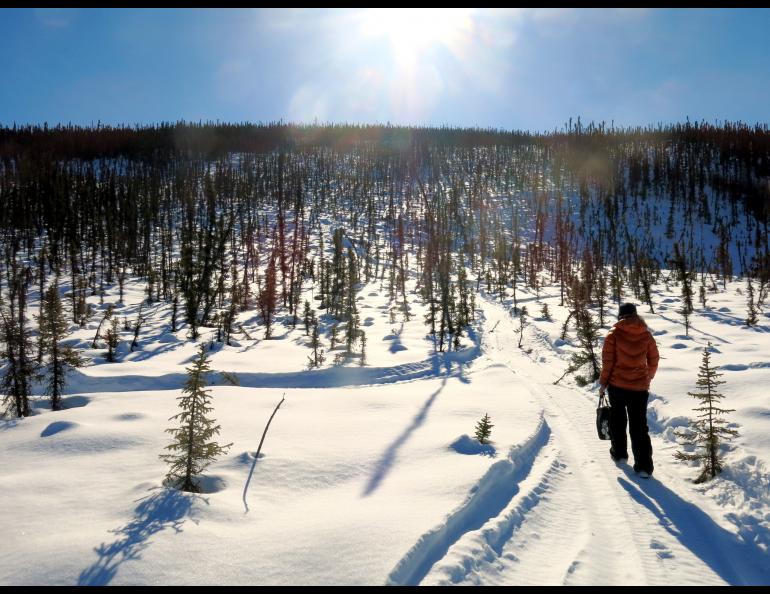

Trees awaken from long winter's nap
POKER CREEK — On this south-facing hillside bathed in spring sunshine, trees are swelling like hot dogs.
“They’re all a little thicker than they were last week,” Jessie Young says of the birch, aspen and occasional spruce in this pleasant open forest about 30 miles north of Fairbanks.
Despite the penetrating warmth of the sun at spring equinox, the woods here in the Caribou-Poker Creeks Research Watershed are as quiet as the blue-gray days of midwinter. More than a foot of snow blankets the ground and the temperature is one degree above freezing.
This relative warmth — more than 30 degrees warmer than just a few days ago — has silently nudged the trees out of their winter sleep, Young says. The ecologist with the International Arctic Research Center at the University of Alaska Fairbanks knows this because she has tapped the trees with instruments. They let her measure what she can’t see.
One of them is a device that resembles a silver belt she fitted around the tree trunks. The band dendrometer allows her to see how a tree plumps in springtime as it pulls water upward from its root system into its water pipeline of xylem tissue.
Wearing a military-type packframe that holds her data-downloading devices in a square plastic carton, Young kneels to squint at the silver band encircling a birch tree at waist level.
“In the last week, this tree expanded 7.7 millimeters (more than one-quarter inch),” she says.
Young hooks another instrument to two pins she drove like a pair of nails into her trees. By hooking probes to the rods, she can tell the moisture content of a tree.
“The wettest tree out here is the aspen,” she says as she connects her computer to a greenish tree with moose-gnawed bark. “This one is about 70 percent moisture.”
On a chilly day one year ago, Young measured a spruce tree that contained just 25 percent water, not far from the 20 percent or less officials from the borough recommend for seasoned firewood. About a week before the trees leaf out, they will be tall cylinders of water, near 100 percent moisture, she says. Leaf-out happens in these parts about May 5, though last year’s cold spring delayed the unfolding of the green until the end of that month.
Young hopes to find out how trees are sucking up moisture when the ground is still frozen. Trees might be pulling tiny amounts of free water from their broad fans of roots, she thinks. Along with the water, the trees are moving carbon to help build their solar panels.
In her quiet grove of trees in this narrow valley, Young is listening to what boreal forest trees are telling her so she can help researchers who model the flow of water over and through the landscape. A warmer climate favors birch, aspen and poplar over spruce.
“I want to know what theses systems are doing, so when things change I’ll know how they might respond,” she says.
Young has calculated that thirst deciduous trees in the Fairbanks North Star Borough will take up 31 billion gallons of snowmelt water this spring. Black and white spruce, which make up about 75 percent of the borough landscape, will move about more than 2 billion gallons of water.
“Black and white spruce are not very active plants,” she says. Spindly black spruce she monitors on an extreme north-facing slope nearby don’t seem to expand at all in springtime or move much water, even in summer.
“Those trees don’t seem to participate in the water cycle,” she says.




